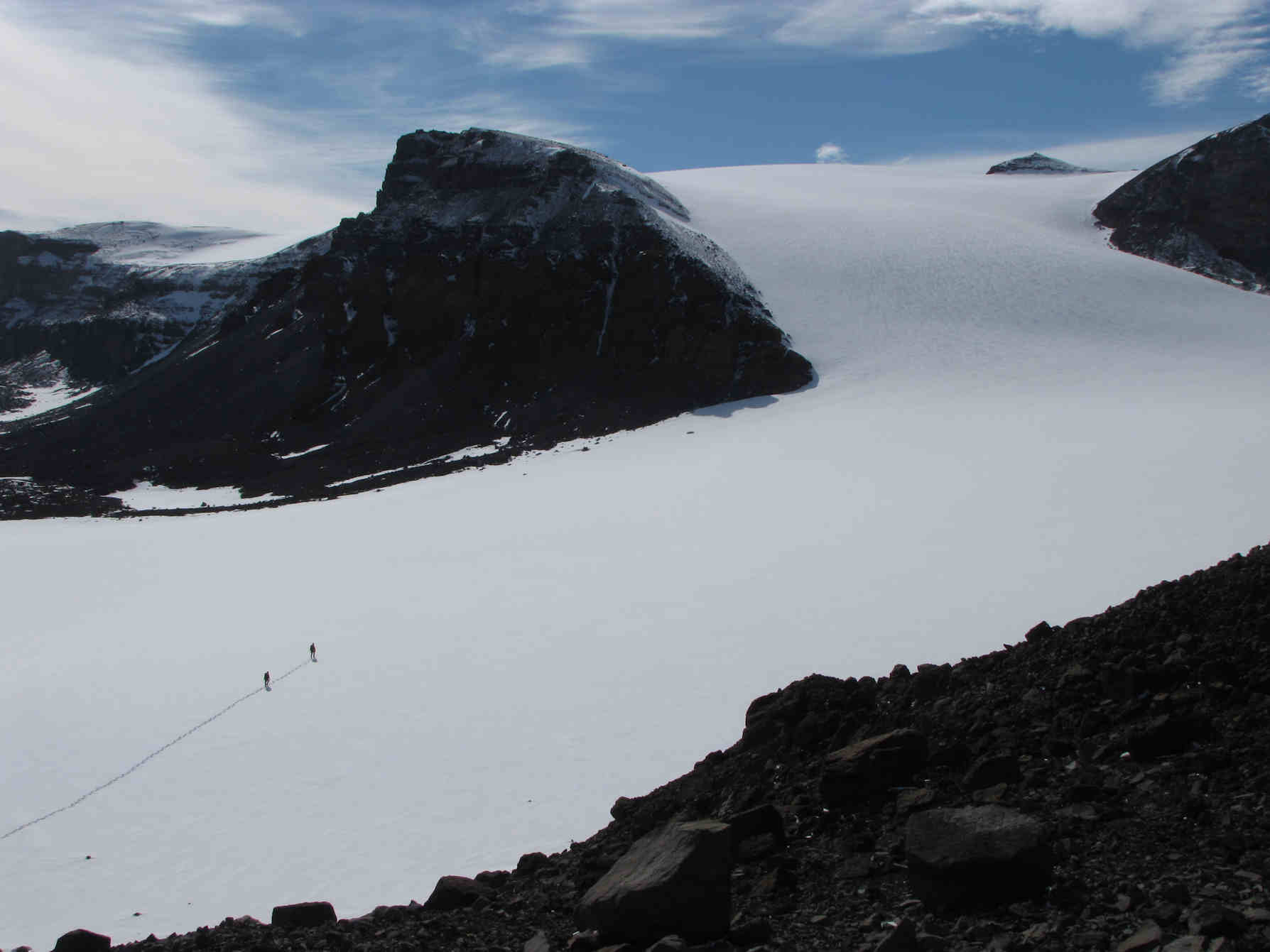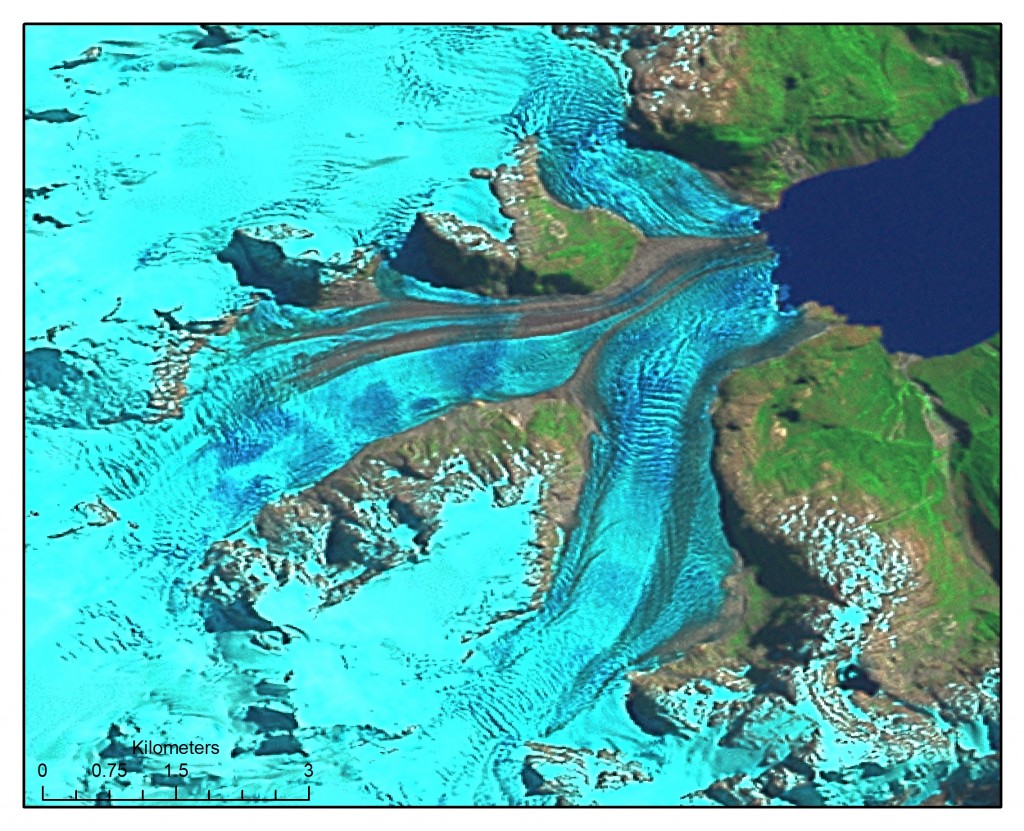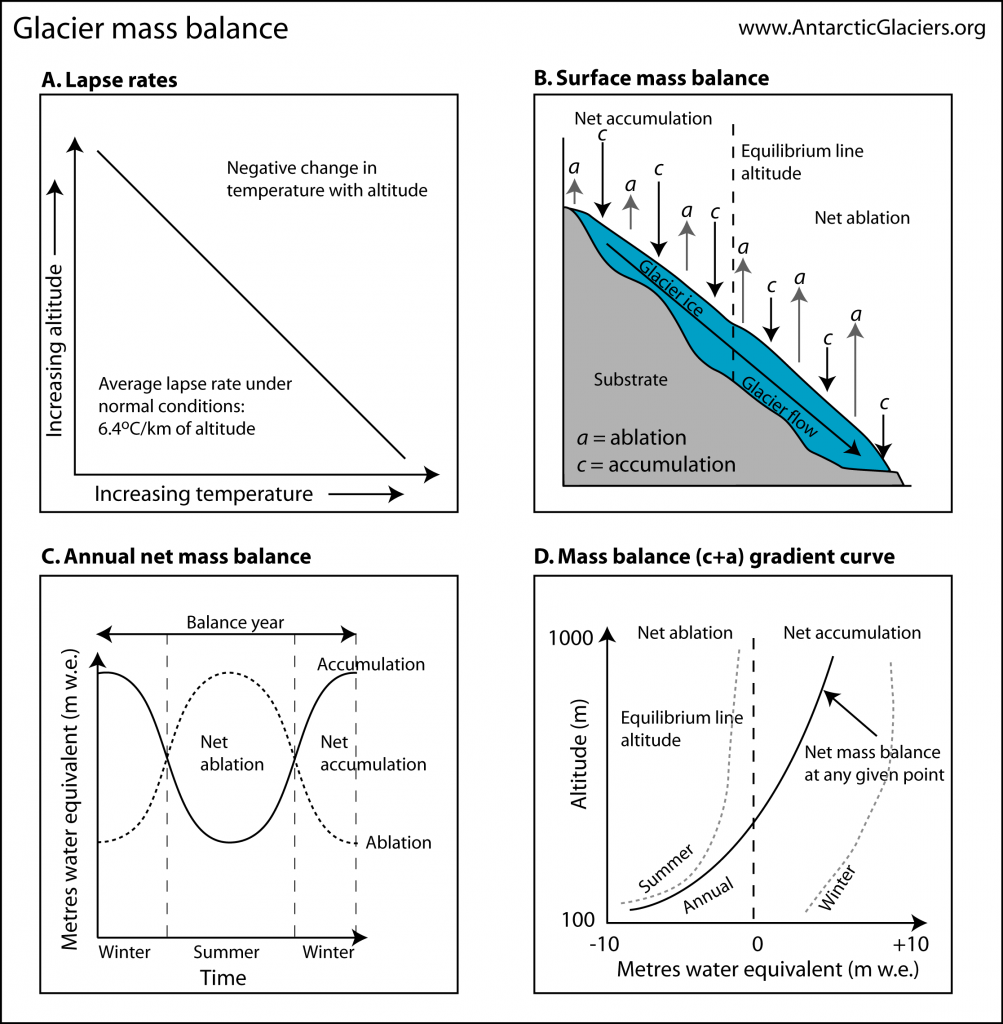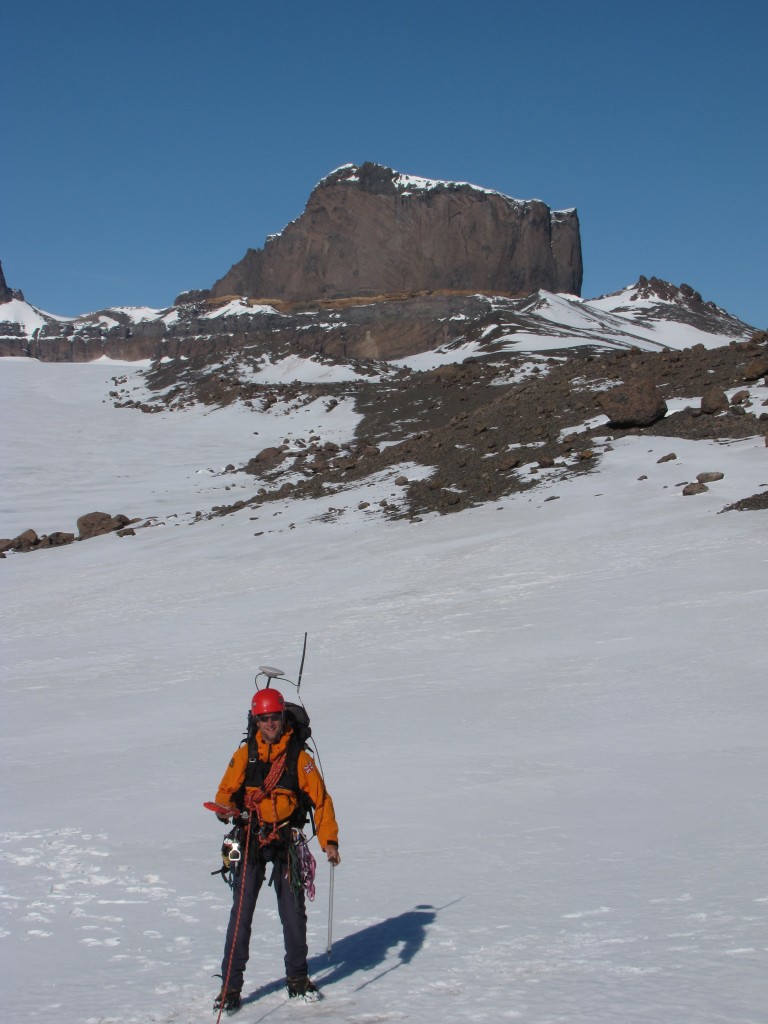what process would you expect to see in the accumulation zone of a glacier?
Glacier mass balance | Measuring mass balance | Mass residue gradients | Mass residuum through fourth dimension | Farther reading | References | Comments |
Glacier mass balance
The mass residuum of a glacier is a concept disquisitional to all theories of glacier flow and behaviour. Information technology is unproblematic enough, actually: mass residue is simply the proceeds and loss of ice from the glacier organizationi. A glacier is the product of how much mass it receives and how much it loses by melting.

Mass residue can be thought of equally the 'health of a glacier'; glaciers losing more mass than they receive volition be in negative mass balance and so volition recede. Glaciers gaining more mass than they lose will be in positive mass balance and will advance. Glaciers gaining and losing approximately the same amount of snow and ice are idea of every bit 'in equilibrium', and volition neither advance nor recede.
For clarification: when we talk about glaciers advancing, receding or being in equilibrium, we are talking well-nigh the position of their snout. Glaciers volition continually flow under the force of gravity; water ice is continually being moved from the upper reaches to the lower reaches, where it melts.
Accumulation zone
The glacier system receives snow and ice through processes of aggregating. Surface accumulation processes include snow and ice from direct precipitation, avalanches and windblown snow. There may be small inputs from hoar frost. The snow and ice is so transferred downslope equally the glacier flows.

Precipitation falling as pelting is usually considered to be lost to the system. Internal aggregating may include pelting and meltwater percolating through the snowpack then refreezing. Basal accumulation may include freezing on of liquid water at the base of operations of the glacier or water ice sheettwo.
The figure below summarises the inputs and outputs from a glacier system; the inputs are the processes of aggregating (including precipitation (snowfall, hail and rain) and other sources of aggregating such equally air current-diddled snow and avalanching.

Ablation zone
The Glaciers as a System figure above summarises the fundamental processes of ablation for a glacier.
Glaciers lose mass through processes of ablation. Surface ablation processes include surface melt, surface meltwater runoff, sublimation, avalanching and windblown snow. Glaciers on steep slopes may besides dry out calve, dropping large chunks of ice onto unwary tourists below. Glaciers terminating in the sea or a lake volition calve photogenic icebergs.

Other processes of ablation include subaqueous melting, and melting inside the ice and at the water ice bed, which flows towards the terminus2.
Equilibrium line altitude
Accumulation usually occurs over the entire glacier, merely may change with altitude. Warmer air temperatures at lower elevations may also result in more precipitation falling as rain. The zone where there is net accumulation (where in that location is more mass gained than lost) is the aggregating zone. The part of the glacier that has more ablation than accumulation is the ablation zone. Where ablation is equal to accumulation is the Equilibrium line altitude.

The snowline at the end of the summer season is often used to demarcate the equilibrium line on satellite images of glaciers. Above the snowline, where at that place is more accumulation than ablation, snowfall remains all year around and the glacier is a bright white colour. Below the snowline, there is more ablation than aggregating, so there is no snowfall left at the end of the summer, and the duller, grayness-bluish coloured glacier water ice is visible.
The figure below shows an outlet glacier of the North Patagonian Icefield. The bright white parts in the upper reaches of the glacier are in the accumulation zone; the darker more than blue areas on the glacier tongues are in the ablation zone. The Equilibrium Line Distance here is approximately equal to the snow line.

Accumulation Surface area Ratio
The Accumulation Area Ratio (AAR) is the ratio of the area of the accumulation zone to the surface area of the glacier. It is a value betwixt 0 and one (Cogley et al., 2011).
The "Balanced Budget AAR" is the AAR of a glacier with a mass residual equal to 0 (i.e., it is in balance with climate, and is neither growing or shrinking). The counterbalanced-upkeep AAR of non-calving glaciers is unremarkably between 0.five and 0.six on average, although the range of variation is substantial, and depends on climatic and topographic factors.
On many glaciers, the AAR correlates well with the climatic mass residuum and the ELA. The correlation is inverse; a lower ELA implies a higher AAR.

So what is Glacier Mass Balance?
And so, glacier mass residue is the quantitative expression of a glacier's volumetric changes through time.In the figure below, Panel A shows how temperature varies with altitude. It is colder at the peak than it is at the bottom of the glacier. This is crucial, as surface air temperature strongly controls melting and accumulation (as in, how much atmospheric precipitation falls as snow or ice).
Mass balance (b) is the product of aggregating (c) plus ablation (a). Mass balance (b) = c + a Mass residuum is usually given in metres water equivalent (thou west.e.). It varies over fourth dimension and space; accumulation is greater in the higher reaches of the glacier, and ablation is greater in the lower, warmer reaches of the glacier (Panel B in the figure).
Mass residue as well varies throughout the year; glaciers typically get more accumulation in the wintertime and more than ablation in the summer (Panel C in the effigy). Glacier mass residuum therefore usually can therefore be expressed equally a mass balance gradient curve, showing how c + a varies attitudinally across the glacier (Console D in the figure). The balance gradient is the rate of change of internet balance with distanceiii. A glacier's net mass balance is a unmarried figure that describes volumetric modify across the entire glacier across the full balance year.

Measuring Mass Balance
Glacier mass balance is normally measured by staking out a glacier. A grid of 'ablation stakes' are laid out across a glacier and are accurately measured. They can exist made of woods, plastic, or fifty-fifty bamboo like you'd use in your garden. These stakes provide indicate measurements at the glacier surface, providing rates of accumulation and ablation.

These methods are time consuming, logistically challenging and backbreaking; the stakes will need to be visited several times through the remainder twelvemonth. Accumulations and ablation are generally measured by reference to stakes inserted to a known depth into the glacier, and fixed by freezing and packing in3. The location is fixed with GPS.
Automated weather stations on the glacier surface are cardinal to understanding free energy fluxes on the glacier. Probing, snowpits and crevasse stratigraphy are also used to measure mass balance on glaciers, ideally supplemented with stakes.
Remote sensing of glacier mass balance is evidently a good culling, equally it allows many glaciers to exist assessed using desk-based studies. It is a cheap and simple alternative to arduous fieldwork, but ground truthing of mass balance measurements will e'er be necessary. Researchers from Aberystwyth University apply satellite measurements to track changes in the mass balance of the Greenland Ice Sheet.
Mass balance gradients
The mass balance gradient of a glacier is a key command in factors such as the glacier's response fourth dimension.
A glacier's mass balance gradient is critically determined by the climatic regime in which it sits; temperate glaciers at relatively low latitudes, such every bit Play a joke on Glacier in New Zealand, may be sustained by very loftier atmospheric precipitation. They will therefore have a greater mass remainder gradient (more aggregating, more than ablation). These moisture, maritime glaciers may have a shorter response time and higher climate sensitivity than cold, polar glaciers that receive piffling accumulation only also have correspondingly depression ablation. These cold, dry glaciers may reply more slowly to climate change.

In the figure in a higher place, temperate glaciers with greater mass rest gradients are represented by the shallower lines; more mass is transferred from the height to the bottom of the glacier. Cold, polar-blazon glaciers with smaller mass residuum gradients are represented by the steeper lines.
Mass balance through time
The Cumulative mass remainder is the mass of the glacier at a stated time, relative to its mass at some before time. Some glaciers take mass balance measurements going back decades, which means that scientists tin can analyse how mass remainder is changing over time.
These measurements give united states of america detailed information virtually climate modify, as glaciers are sensitive 'barometers' to our irresolute world. Usually, the cyberspace mass balance over the remainder twelvemonth is plotted on a graph. At that place are several projects monitoring glaciers all over the globe, and these analyses show that glacier mass residual is more often than not decreasing (becoming more than negative) over fourth dimension.
In Europe, European Environment Bureau has records of many glaciers, and makes their cumulative mass balance measurements publically available. The Glaciers (CLIM 007) analysis shows that the vast bulk of European glaciers are receding, with the charge per unit of recession accelerating since the 1980s.

The Northward American region shows a like trend, with a generally failing mass balance each year.

Further afield, the IPCC AR4 shows cumulative specific cyberspace mass residuum of glacierised regions worldwide. The differing behaviours of different regions shows the variable strength of climate modify.

Further reading
More than information on glacier accumulation and ablation
How glaciers flow:
- Deformation and sliding
- Stress and strain
Also of interest:
- Glacier thermal authorities
- Glacier response time
- Antarctic Ice Sheet surface mass balance
Wider reading:
- Glossary of glacier mass rest and related terms (Cogley et al., 2011)
- Water ice sheets and ocean level: thinking outside the box (Van den Broeke et al., 2011)
- World Glacier Monitoring Service
- Glaciers (CLIM 007) Assessment
- Mass balance data 2011-2012
- North Pour Glacier Climate Projection (Mauri Pelto)
Source: https://www.antarcticglaciers.org/glacier-processes/mass-balance/introduction-glacier-mass-balance/#:~:text=The%20glacier%20system%20receives%20snow,downslope%20as%20the%20glacier%20flows.
0 Response to "what process would you expect to see in the accumulation zone of a glacier?"
Post a Comment